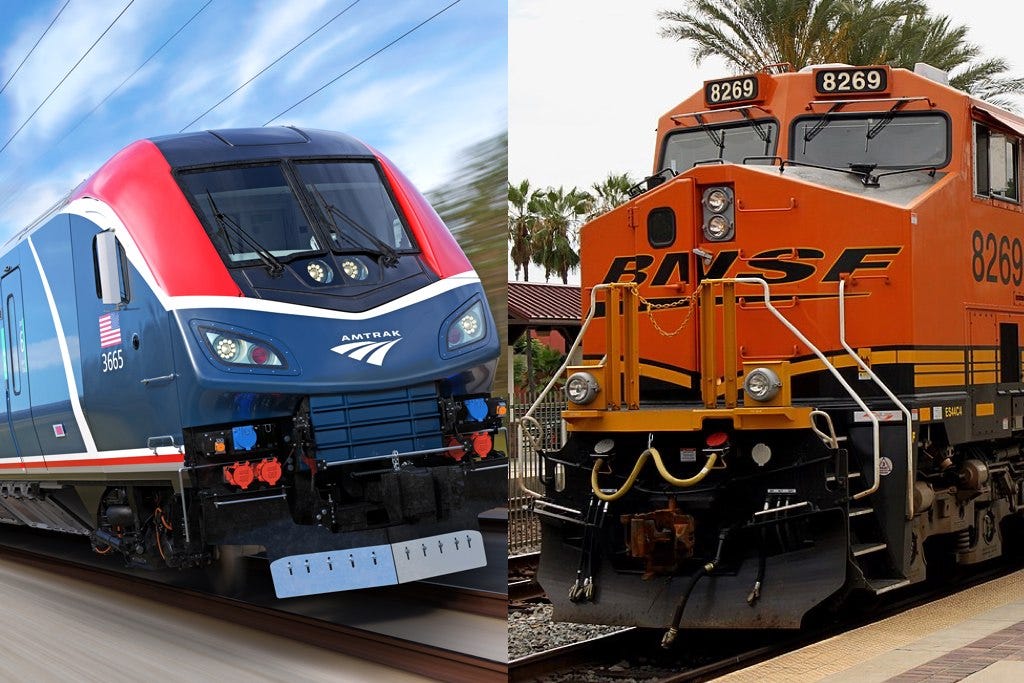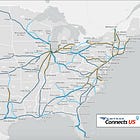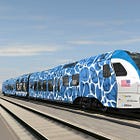Inside the battle between Amtrak and the freight railroads
A top railroad regulator on why new rules are needed to get the freights to act in the public interest.

Amtrak and the freight railroads are on a collision course. Amtrak is embarking on an unprecedented expansion, adding new lines across the country and increasing service on existing corridors. Meanwhile, the freight companies that own the vast majority of the nation’s rail network are trying to squeeze all of the value they can out of their tracks through “precision scheduled railroading.” That means maintaining only the infrastructure they deem absolutely essential and running trains as long as possible. Something’s gotta give.
Trouble has been brewing for a long time. Amtrak pins the majority of its notorious delays on the freight railroads, claiming that these companies are shirking their legal obligation to give priority to passenger trains. As it attempts to start new lines, like one connecting New Orleans and Mobile, Amtrak is getting into bitter fights with freight companies that say Amtrak needs to pay for extensive infrastructure upgrades before running its trains. Many of the core issues in this dispute could be brought to light in an ongoing legal battle pitting Amtrak and Union Pacific.
Since a narrowly averted strike at the end of 2022, railroad workers have started criticizing their bosses more vocally. In addition to asking for better wages and benefits, workers have called on Congress to limit train length, establish minimum crew sizes, and generally improve safety onboard and for the communities trains pass through.
But Amtrak and railroad workers face a formidable foe. In a repeat of the Gilded Age, the railroads are once again some of the hottest companies on Wall Street. Six of the seven big railroad companies paid out $146 billion in stock dividends and buybacks over the course of the 2010s, $30 billion more than they invested in their businesses. And Wall Street thinks short term profits can go higher still, even when railroad executives would prefer to invest in long term upgrades.
No one has had a more intimate view of the relationship between Amtrak and the freights than Martin J. Oberman. This month, he retired as chairman of the Surface Transportation Board, the federal agency that mediates conflicts between competing railroad companies. He’s also been involved in local politics, as a Chicago alderman, and transit governance, as the chairman of the board for Metra, the Chicago area commuter rail agency. I reached out to him as part of my book research, but we ended up covering far more ground than I’ll be able to get to in my chapter on railroads. Our conversation felt too timely, too wonky, and too valuable to consign to my notes. The below interview has been condensed for clarity.
BS: Amtrak officials talk a lot about the freight railroads being an impediment to running trains on time, or to Amtrak increasing service on its routes. Is that a fair assessment by Amtrak?
MO: It's very much a legitimate concern.
One of the things that has really frustrated me is that when Congress set up this system it put no restrictions on the freight railroads removing infrastructure. If a railroad has a triple track from Chicago to New York, and it decided it just wanted to pull up the tracks and just leave it as a single track line, it can do that without asking anybody's permission. And the railroads want to do that when they can because it is very expensive to maintain tracks.
My first year on the Board, I had to go to an industry meeting in Paducah, Kentucky from Chicago. It's not easy to fly there, so I decided to take the Amtrak. I rode the whole 307 miles with the engineer. The road bed and right of way that whole 307 miles is absolutely beautiful. It’s perfectly set up for a double track the entire way, and there was a double track there until the mid 90s. But after Canadian National bought it, they tore it up.
So four times on the trip, we had to pull over into a siding, which takes longer than you would think. We lost a fair amount of time. It was ridiculous. If the double track had been there, we wouldn’t have had to do that. You have that situation all over the country.
The railroads are like the person who murders his parents and then asks for mercy as an orphan. They want to say, well, we don't have enough infrastructure. Yeah, because they took it all up.
How much does operations play into this? Are there other things freight companies could do to help ameliorate these problems without building all of this expensive new infrastructure?
You can improve the situation with operational changes, as well as adding infrastructure. Suppose there was a law that says you can't run a freight train longer than the sidings on the line you're running on — which is not the case now. Obviously, the freight railroads would scream and yell. Their whole ability to fire 30% of the whole workforce over the last 10 or 15 years is based on running fewer, longer trains.
This is not an all or nothing. There are some places where it's actually good for the country, good for the economy and definitely environmentally good to run a long train. But it's gotten out of control.
We’ve talked about freight infrastructure and operations causing delays on Amtrak. Are there other legal efforts or political changes that could help improve things?
Amtrak has the worst of all worlds. First of all, Congress, at least parts of Congress, are constantly saying you need to figure out how to run it at a profit. Well, that is a stupid mandate, they cannot possibly run it at a profit.
Then, when Amtrak has tried to cut back on routes where there's very few passengers, whoever the Congressman is whose district is affected screams and yells and says, don’t you dare cut off my train! But I'm still not going to give you enough money to run the train there.
What do you think about the current distribution of costs between Amtrak and the freight rail companies? Are the freight rail companies paying their fair share? Is Amtrak paying its fair share?
What I can tell you is that in the last 12 years, the railroads have taken a quarter of a trillion dollars out of their businesses and given it back to their shareholders. So the shareholders could still make a lot of money, and you could have taken some billions of dollars and kept it in the system. If they just improved their own infrastructure, which they ought to do for better freight service, that in itself would help Amtrak.
No, I don't think the freight railroads are paying their fair share given the last 20 years of profit margins. Prior to that time, the railroads did have to climb out of the bankruptcy holes they were all in in the 60s and 70s. But they're well past that since at least 2005.
And, by the way, Wall Street is continuing to put pressure in the other direction, as we saw with this proxy fight over the control of Norfolk Southern that ended a couple of weeks ago. That was an effort by activist shareholders to try to force Norfolk Southern to cut back on what it was spending. It has a new CEO, who was at least more progressive and farsighted compared to past executives, and he was being punished for it.
Is that something that federal regulations could address? Like if the railroads are earning a certain amount of money, they ought to reinvest a certain amount of it in the system?
When you say it that way, it smacks of utility regulation, which the railroads hate that idea.
And they're not regulated like that for now.
They are not regulated like that for now. There are some vague parts of the old Staggers Act [the 1980 law that effectively deregulated the railroad industry] about how railroads could only raise their rates enough to have adequate revenues. There are elements of that in the law but they've never really been fine tuned. You’d need some significant statutory change.
I am not shy about regulation, but I think trying to have the government figure out what the right numbers are would be really problematic. Railroad economics are very complex. I think the way to go about it is to try to incentivize railroads to do better rather than mandating that they have to do better, but to have consequences if they don't.
It's kind of like this Reciprocal Switching Rule, which the Board enacted just before I left, which says if your service falls below a certain standard, then your customer is entitled to switch their traffic to a competing railroad. If you don't want that to happen, provide better service.
I've written about the effort to decarbonize the railroad sector and move it to clean energy. I'm wondering if you’ve looked into that as part of your work on the Board. I'm specifically interested in this question of whether the industry will pursue hydrogen trains or will try to electrify significant stretches of track.
That is really not within the Board's jurisdiction. Technical requirements are at FRA. So I haven't spent much time looking into it.
But if I were looking at the best way to decarbonize, it would be to focus immediately on more rail, even if that meant diesel fuel. Every rail car holds the same amount of freight as four semis. So if you have a 100 car train, and a lot of them are longer, that's 400 semis that aren’t on the road.
Just to give you one example: The Burlington Northern and JB Hunt, which is one of the biggest trucking companies in the country, entered into a joint agreement last fall for BN to start moving more of JB Hunt’s traffic. But in order to do that the railroad has to deliver that kind of intermodal traffic very quickly and on time, because trucks are much more reliable in that sense.
What BN announced is that they were going to have a 95% on time performance, which was just as good as JB Hunt can do with trucks. I asked [BN CEO Katie Farmer] how they were going to accomplish that. They are adding double track to most of their main lines, triple tracking parts of it, and investing billions of dollars in several intermodal rail yards. And what they're aiming at is getting 11 million JB Hunt truck loads per year off of the highway. It's going to take a number of years to get there, but that is a much faster way to protect the environment than to reduce the diesel emissions from a very small number of locomotives.
I imagine the same logic goes for passenger trains, right? You can move a lot more people in a diesel passenger train than in a bunch of electric cars.
That's probably right. Remember, in order to move people in electric cars, you’ve got to have more highways and so forth.
I don't know that we'll ever get there, certainly not in my lifetime, but since I was on the city council in the 70s, and undoubtedly before, there were rail advocates talking about using Chicago as the hub of a wheel with spokes going to every big city within 300 miles. So imagine Minneapolis, Milwaukee, Detroit, Indianapolis, Cincinnati, St. Louis, Kansas City, each having a high-speed train. If it was a real Japanese or European high-speed train, you would eliminate a huge amount of air traffic. You would eliminate a lot of traffic on the highways. People don’t need cars if they’re going to get right into the center of the city.
That kind of a passenger situation would be a huge boon to the environment and a huge boon, I think, to urban development. But you're talking about trillions of dollars of public investment to ever get to that kind of a system. One hundred years from now, we probably will get there. But we've never made the kind of investment that should be made.






With all due respect the double track complaint is rather weak. Even Oberman [sic] admits that there's a huge cost to it. The freights don't need all that capacity. If you want to run Amtrak trains faster with double track the onus is on the federal government to pay for that.
And note that back from the Obama days rules were put into place in regards to what constitutes giving passenger trains priority. Whatever problems there were in the past the only train that doesn't meet those right now is the thrice weekly Sunset Limited.
As far as I can tell the core of that issue is UPS Southern transcon is congested. It's not an issue of up not wanting to keep those passenger trains moving. They just don't have the capacity. Maybe I've got that wrong.